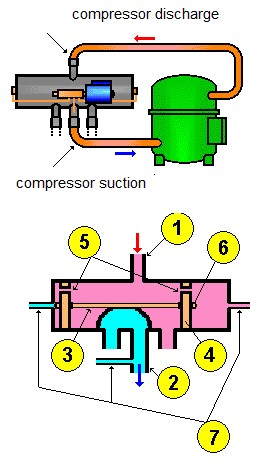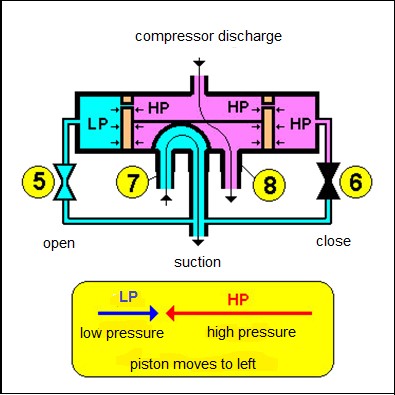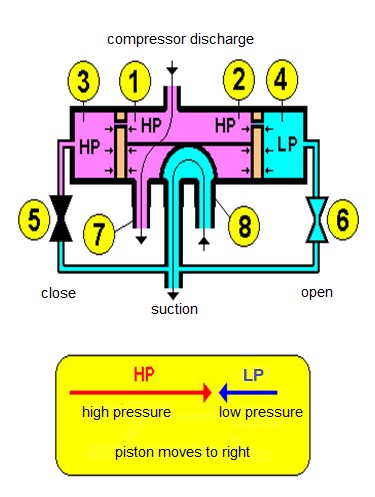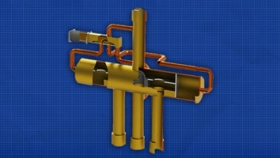4-way reversing valves are used in most heat pump systems in refrigeration cycle. The valve reverses the flow direction of the refrigerant.

As you see in the picture, the 4-way reversing valve consists of a body with two inlet and two outlet lines and a solenoid pilot valve with a coil. It is powered to change the flow direction of the refrigerant.
From the 4 pipe connections of the reversing valve, three are located under the body and one on top of the body. The top pipe connection (number 1) should be always connected to the compressor discharge line in the refrigeration system. The middle pipe at the bottom (number 2) should be connected to the compressor suction line. There are two pistons attached to each other by an axle (numbers 3 and 4). There is a small hole on each piston (number 5) and at the end of each one, there is a needle like part (number 6). The capillary tube three connections are also on the valve body (number 7) which are connected to the solenoid valve in the refrigeration system.
All the reversing valve components we talked about, affects its proper function. So any tiny problem with one of them can disrupt its operation. Let's know about the reversing valve function in refrigeration system for its better troubleshooting.
How does a reversing valve work?
Whenever the solenoid valve is powered, you can hear a noise. But it doesn't mean the piston is moving. Look at the following picture:

The compressor discharge (high pressure or HP) and compressor suction (low pressure or LP) are connected as you see. We are using two hand valves in the capillary tube line in refrigeration system for better understanding the process.
The valve number 5 is open and valve number 6 is closed. As you see, inside the reversing valve, the compressor discharge pressure is on both pistons. Since the level of pistons are similar, the axle has no movement and remains still.
The HP is exerted to the back of the pistons through the hole on the pistons. But since the LP is exerted to left piston by the capillary tube and the capillary tube diameter is more than the diameter of the hole on the piston, so the whole piston assembly moves to left and the pipe number 7 (the middle connection) is connected to the compressor suction line. On the other hand, the compressor discharge is connected to pipe number 8.
Now look at the following picture. We close the hand valve number 5 and open the hand valve the number 6. Now the compressor suction pressure is exerted to the right piston. So the whole piston assembly moves to right. Now the pipe number 7 is connected to the compressor discharge and pipe number 8 is connected to the compressor suction.

In this way, the refrigerant flow direction changes by pipes 7 and 8. So the heat exchanger which was functioning as an evaporator now is converted to a condenser.
In fact, the solenoid valve does what the hand valves did in this example. Once, the compressor suction pressure is on the right piston and then the pressure is on the left piston.
If you need more information about refrigeration system and its components, don't miss refrigeration training course (cold room and chiller) in HelloTechnic website


